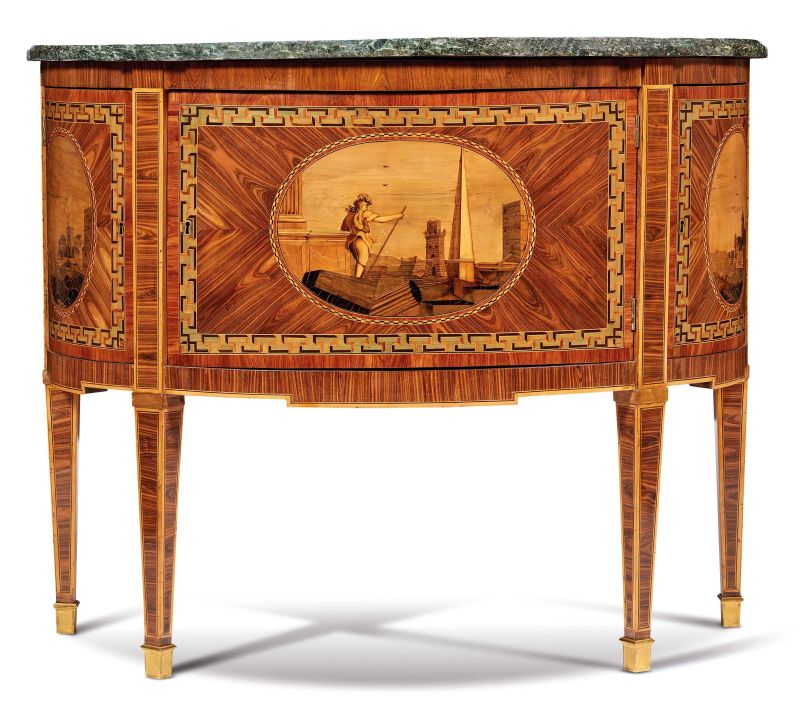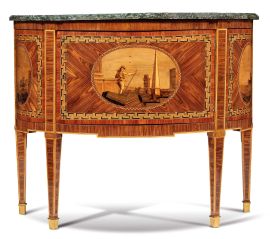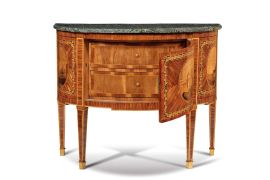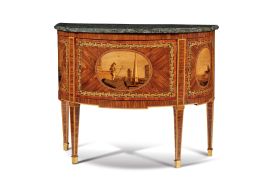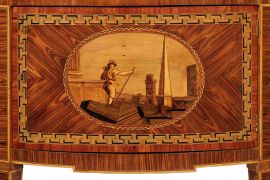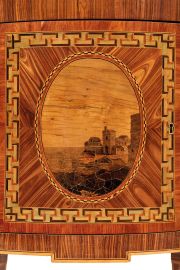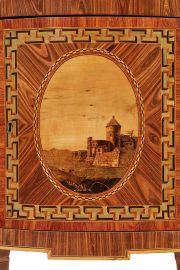Ignazio and Luigi Ravelli
(Vercelli 1756-1836 / 1776-1858)
DEMI-LUNE COMMODE, LATE 18TH CENTURY
rosewood veneer, painted wood inlays, Verde Alpi (green) marble top, 96x117x56 cm
Bibliography
Auctores varii, Genio e maestria. Mobili ed ebanisti alla corte sabauda tra Settecento e Ottocento. Exhibition catalogue (Venaria Reale, 17 March -15 July 2018), Turin 2018, p. 288 cat. 67
This elegant marquetry commode, an outstanding example of the Italian neoclassical style (1700-1800), was created by two renowned Piedmontese cabinetmakers, Ignazio Ravelli (1756-1836) and his son, Luigi (1776-1858), who were active in Vercelli between the second half of the eighteenth century and the early years of the nineteenth. During that period, cabinetmaking and furnishings in general were strongly influenced by the Louis XVI style and the return to the values of beauty, purity, simplicity, order and rationality typical of classical antiquity. According to their creative talents, artists assimilated similar features through various ornamental motifs: rosettes, trophies, friezes, acanthus leaves, frets, decorated ovals, architectural caprices and mythological scenes. In Habsburg-controlled Lombardy, the art of intarsia or marquetry reached a peak in Giuseppe Maggiolini’s elegant and meticulously executed works. Ignazio Ravelli belongs in this context: he took Maggiolini’s work to a new level while, however, favoring scenes with architectural fantasies such as caprices of ruins, drawing inspiration from engravings by Giambattista Piranesi, Ferdinando Galli di Bibbiena and Vincenzo Mazzi. Ignazio Ravelli was born in Vercelli in 1756, and began manifesting a marked talent for drawing and architecture while still a child. Some document sources confirm that in 1789 he was already enjoying the patronage of the King and by 1791 was receiving a royal stipend with the permission to display the royal coat of arms in his workshop. There is a interesting anecdote about his decision, made at a young age, to devote himself to art: during the king’s visit to his hometown, the sovereign’s admiration for Paolo Sacca’s work on the Basilica of Sant’Andrea led Ravelli to embark on a career in cabinetmaking and marquetry to equal, if not surpass his predecessor. In fact, in 1829 he was commissioned to restore the wooden choir stalls that had so greatly impressed the king. Over the ensuing years, his intarsia pictures spread his fame to many European countries. Writing around forty years after the master’s death, the words of Count Finocchietti, a Tuscan nobleman with French origins, bear witness to the fame and skill Ravelli attained over the years: his works could be found in the most fashionable salons of Vienna, Paris and Madrid.
The master’s distinctive chiaroscuro style is evident in this demi-lune commode. Here too, there is a central door that conceals two inlaid drawers and two side doors each decorated with an oval containing a scene and framed by “three-dimensional” Greek key motifs, on a pale-green tinted wood background, with the same number of vertical and horizontal frets. His son used the same arrangement on a commode now in the Museo Civico di Palazzo Madama in Turin (see R. Antonetto, 2010, p. 332 fig. 14 A). In the commode presented here, the central medallion is dominated by an unusual figure viewed from the back and standing decidedly in an architectural setting. The figure, that can be identified as a soldier or god because of the spear in his right hand, is gazing at a group of mysterious buildings beneath a dazzling sky. This same figure can be seen on the right door of a commode in a private collection (see R. Antonetto, 2010, p. 331 fig. 11) and could be a harbinger of De Chirico’s metaphysical style. The side doors are decorated with coastal scenes that are much simpler in terms of rendering and subjects: with a fortress and a large tower on the left and right, respectively. Completed by a green Verde Alpi marble top, the piece is an example of incomparable mastery not only in the chiaroscuros punctuated by elegant passages using different shades in the inlays, but mainly by the compositional arrangements of the wood species Ravelli used.
References
V. Viale, Mostra del Barocco piemontese, Turin 1963, vol. III, Mobili e intagli, plates 217-218;
R. Antonetto, Minusieri ed ebanisti del Piemonte, Turin 1985, 350-352;
E. Quaglino, Il mobile piemontese, Novara 1997, p. 156;
R. Antonetto, Il mobile piemontese nel Settecento, Turin 2010, pp. 330-333

